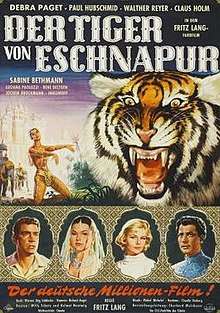The Tiger of Eschnapur (1959 film)
| The Tiger of Eschnapur | |
|---|---|
 German film poster | |
| Directed by | Fritz Lang |
| Produced by | Artur Brauner |
| Screenplay by |
Fritz Lang Werner Jörg Lüddecke Thea von Harbou |
| Based on | Das indische Grabmal by Thea von Harbou |
| Starring |
Debra Paget Paul Hubschmid Walter Reyer |
| Music by | Michel Michelet |
| Cinematography | Richard Angst |
| Edited by | Walter Wischniewsky |
| Distributed by |
Fantoma Omnia-Film Polyband GmbH |
Release date |
|
Running time | 101 minutes |
| Country |
West Germany France Italy[1][2][3] |
| Language | German |
The Tiger of Eschnapur, or in original German, Der Tiger von Eschnapur, is a 1959 West German-French-Italian adventure film directed by Fritz Lang.[1] It is the first of two films comprising what has come to be known as Fritz Lang's Indian Epic; the other is The Indian Tomb (Das Indische Grabmal). Fritz Lang returned to Germany to direct these films, which together tell the story of a German architect, the Indian maharaja for whom he is supposed to build schools and hospitals, and the Eurasian dancer who comes between them.
Prior works
Lang's Indian epic is based on work he did forty years earlier on a silent version of Das Indische Grabmal. He and Thea von Harbou co-wrote the screenplay, basing it on von Harbou's novel of the same name. Lang was set to direct, but that job was taken from him and given to Joe May. Though Lang did not control the final form of that earlier version, it is one of his most revered films.
Released in 1921, the original version of Das Indische Grabmal had a running time of 31⁄2 hours. For the remake, Lang divided the story into two parts that each run about 100 minutes, a length modern audiences can more easily accept.
Plot
The tale begins when architect Harold Berger (Paul Hubschmid) arrives in India and travels to the kingdom of Maharaja Chandra (Walter Reyer), for whom he will build schools and hospitals. En route to the Maharajah's palace, Berger travels with a temple dancer named Seetha (Debra Paget), who has also been invited by the Maharajah, and saves her from a tiger. Seetha, whose father was European, has inadvertently caused the Maharajah to become infatuated with her, but she and the architect begin to fall in love. Predictably, this leads to tension between Chandra and Berger, exacerbated by scheming courtiers who believe that the Maharajah's potential marriage to the dancer could become a pretext for toppling him. The film is filled with action: a highlight is Seetha's ritual dance. At the end of Tiger, Seetha and Berger escape together into the desert just as Berger's sister and her husband, an architect who works with Berger, arrive in Eschnapur. Chandra informs them that he now wants a tomb to be built for Seetha before any further work on the commissioned buildings.
Cast
- Debra Paget as Seetha
- Paul Hubschmid as Harold Berger
- Walter Reyer as Chandra
- Claus Holm as Dr. Walter Rhode
- Luciana Paluzzi as Baharani
- Valéry Inkijinoff as Yama
- Sabine Bethmann as Irene Rhode
- René Deltgen as Prince Ramigani
- Jochen Brockmann as Padhu
- Richard Lauffen as Browana
- Jochen Blume as Asagara
- Helmut Hildebrand as Ramigani's servant
- Guido Celano as General Dagh (uncredited)
- Victor Francen as Penitent (uncredited)
- Panos Papadopoulos as Courier (uncredited)
- Angela Portaluri as Peasant woman (uncredited)
Production
The film was shot on location in India with a predominantly German cast.[4] Lang was able to get permission from the Maharana of Udaipur to shoot at many locations that were normally barred to Western film crews. One of these was the floating Lake Palace seen much later in Octopussy.[5]
Releases
The two films were edited down into one 95-minute feature courtesy of American International Pictures and released in the US in 1959 as Journey to the Lost City—with Seetha's dance scenes heavily trimmed, courtesy of the Hays Office. The negatives of Fritz Lang's original films were thought to be lost, but recently a set was rediscovered. Fantoma Films restored them to DVD format, producing one disc for each film. The discs contain both German and English dialogue tracks, plus other extras. They were released by Image Entertainment in 2001.[6]
Trivia
- Another film titled Der Tiger von Eschnapur was released in Germany in 1938. It too was based on Thea von Harbou's novel Das Indische Grabmal (The Indian Tomb). The film was directed by Richard Eichberg and written by him along with Hans Klaehr and Arthur Pohl.
References
- 1 2 Mannikka, Eleanor. "The Tiger of Eschnapur". Allmovie. Rovi Corporation. Retrieved February 18, 2013.
- ↑ "Der Tiger von Eschnapur". BFI Film & Television Database. London: British Film Institute. Retrieved February 18, 2013.
- ↑ "Der Tiger von Eschnapur". Filmportal.de. Retrieved February 18, 2013.
- ↑ Bergfelder, Tim (2005). International Adventures: German Popular Cinema and European Co-productions in the 1960s. Berghahn Books. p. 119. ISBN 978-1-57181-538-5.
- ↑ DVD Savant Review: The Tiger of Eschnapur & The Indian Tomb
- ↑ dOc DVD Review: The Tiger Of Eschnapur (1959)